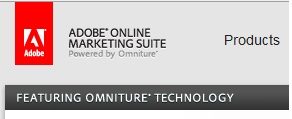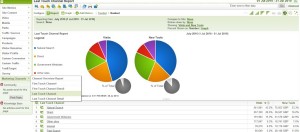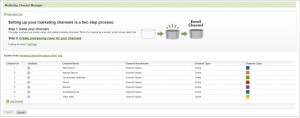Marketing Channel Reporting in Omniture

Recently I was involved in some top secret, hush hush beta testing. But enough of virtually every single Google product that there is out there, I’ve actually been beta testing some exciting new Omniture products that were released with version 14.8 of their SiteCatalyst tool. Of course most of the chat around has been about how Omniture has now changed to Adobe Marketing Suite, but the casual rebrand and slightly different colour scheme for the home page is a bit more incidental to those who already use the tools.
Of more interest to me was something that Omniture Adobe have introduced that many other tools already have – which is the Marketing Channels report. In Google Analytics you can see this report by going to your Traffic Sources report and selecting to just show the medium, although this normally defaults to Source Medium, which will show you the website and the medium. Note that this isn’t as silly as it sounds as you could have one source which is more than one medium (eg users coming from Google as a referrer, organic search, email, etc).
With Google you are limited a bit in what you can have as your mediums. You have the ones that you have set up as campaigns, plus organic, paid and now it appears twitter. Everything else gets bunged into referrer (if it has one) or not set (if it doesn’t). This means you need to make sure you set up your campaigns in the right way in the first place, otherwise your classifications here are going to be slightly out (ps it can be quite funny googling links for this blog – “whencanistop campaigns” in Google gave me some links to quit smoking!).
With SiteCatalyst your choices always used to be slightly limited. You had a Referrer type report, however this was very limited – it would tell you how many came from search engines, direct and referring websites, but that was about it. Not only this but your options were limited to just ‘instances’ which is a rubbish metric which should be retired.
The new channel report does that extra level that you always thought SAINT classifications should be able to in your referring domains report, but could never quite do. What this can now do is come up with some proper conditional logic that allows us to claim all of our traffic in a particular way. Here below is how I’ve set up our traffic:
It’s highly critical that you set this up in the correct way, otherwise you’ll have the wrong buckets of data in the wrong place. For example you have to make sure that you have your paid search before your organic search otherwise all your paid search may accidentally end up in the organic search before you’ve had a chance to include it.
Just out interest – you direct traffic is automatically set up to be only included if it is the first page of the visit. Keep it like this, because if you don’t then you might find lots of visits that weren’t direct being included as they may not have a referrer in mid visit (some browsers and anti-virus software do this automatically without the user noticing). The other thing that I’ve done is that I’ve set these up so that they only count on the first page of the visit for all of the different types. Why? Because I want this to reflect the start of the visit. If someone comes from Twitter, but quits their visit mid way through to search in Google before coming back to the right place in the journey, I want it to be associated with Twitter. We also have situations where the user can leave the site for an alternative journey and then come back, we don’t want those clicks to be associated with the second website.
Because these are effectively a custom conversion report, they allow you to do all the things that you can with other custom conversion reports. Notably you need to think about your conversions and your visits for each of your individual channels. If you’ve set up your revenue reports in this way you can of course work out for each of your channels which individual source is the most costly (although don’t forget to count your lifetime value of each of your sources in a backend database, if you can).
The other thing that your marketing channels report does something very clever with its breakdowns. With organic search it is easy because you’ve got those reports already – your breakdown of your keywords is a standard report. However the ability to breakdown your direct traffic by the page that the user arrives at is something that wasn’t previously possible. In fact, you might want to do this for your organic search as well, as you don’t really want to have to waste an ASI on Organic search just to find out which are your top landing pages in Google.
The other thing that SiteCatalyst does really well here that I haven’t seen anywhere else is that you can not only view your reports based on the most recent channel (in this case the most recent visit), but you can also view your reports based on the first channel that the user came by. This allows you to find out if your paid search is causing users to convert, but that they need more than one visit to do so. Don’t forget of course that users can delete their cookies so if your conversion is more likely to be multi visit expect lower conversion rates on your first touch channel.






Leave a Reply